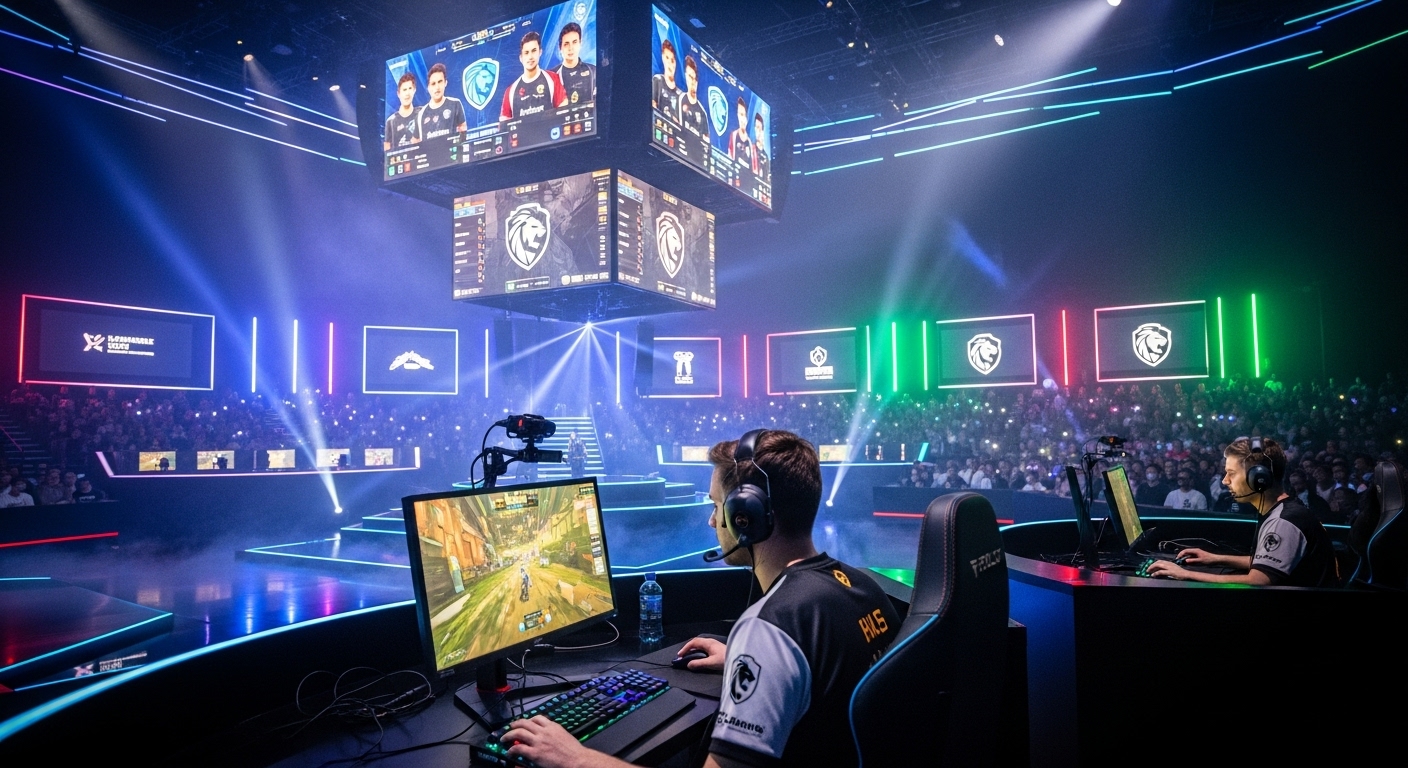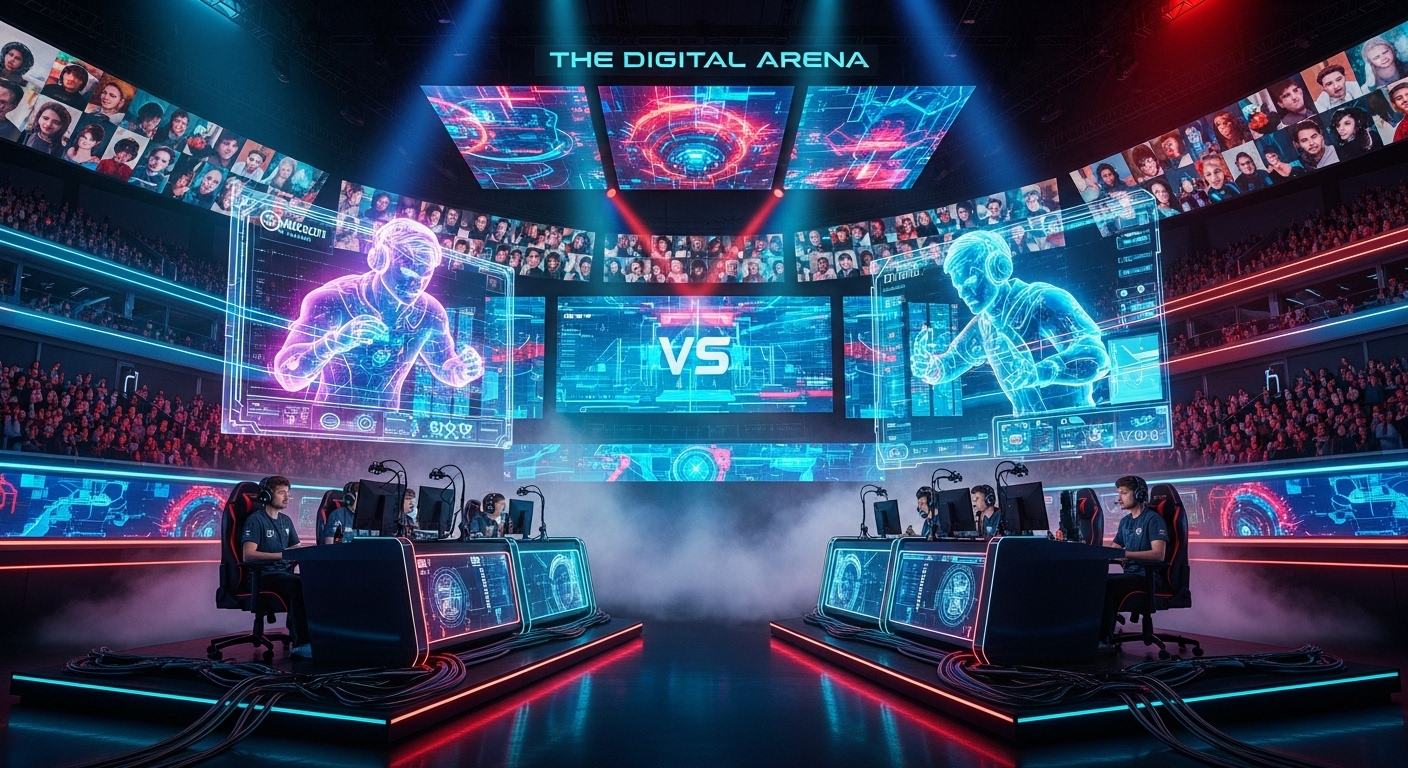Introduction to Esports
Esports, short for electronic sports, has evolved from a niche pastime into a global entertainment and competitive phenomenon. What once began as friendly matches between gamers in local arcades or computer cafes has transformed into a billion-dollar industry that commands the attention of millions worldwide. The term esports encompasses organized, multiplayer video game competitions, particularly between professional players, individually or as teams. Today, esports has become one of the most dynamic sectors in entertainment, merging the thrill of sportsmanship, the precision of strategy, and the power of technology into one cultural force.
The esports industry’s meteoric rise can be traced to several factors: technological advancements, streaming platforms, international tournaments, sponsorship deals, and the growing acceptance of gaming as a legitimate sport. In just two decades, esports has gone from being a hobby for a few to an organized, professional career path for many.
The Early Days of Esports
The roots of esports can be traced back to the early 1970s when video games first appeared in arcades and universities. The first recognized competitive gaming event was held at Stanford University in 1972, where students competed in a game called Spacewar!. The winner received a one-year subscription to Rolling Stone magazine—a humble reward by today’s standards, but a symbolic start to what would become a massive competitive industry.
The 1980s saw the rise of arcade gaming culture, with titles like Pac-Man, Donkey Kong, and Space Invaders dominating the scene. In 1980, Atari hosted the Space Invaders Championship, attracting over 10,000 participants and marking the first large-scale video game tournament in history. By the 1990s, advancements in internet connectivity and personal computers paved the way for competitive gaming on a broader scale. Multiplayer titles such as Doom, Quake, and StarCraft became the early pillars of organized competition, often held at LAN (Local Area Network) parties where gamers connected their computers to battle in real-time.
The Birth of Modern Esports
The modern era of esports began in the 2000s, thanks to improved internet infrastructure and the rise of online gaming platforms. South Korea played a crucial role in popularizing esports globally. After the Asian financial crisis of the late 1990s, South Korea heavily invested in broadband technology, creating the perfect environment for online gaming. The country’s dedication to gaming culture led to the establishment of professional leagues, teams, and even televised esports events. Titles like StarCraft: Brood War became national sensations, turning players such as Lim “BoxeR” Yo-hwan into celebrities.
As esports matured, other countries followed suit. North America, Europe, and China began organizing professional leagues and global tournaments. The growth of platforms like YouTube and Twitch further fueled the expansion of esports, enabling fans to watch live matches and connect with their favorite players and teams.
The Rise of Esports Titles and Genres
Esports is not defined by one single game or genre—it encompasses a wide range of video games that test players’ skill, reflexes, strategy, and teamwork. Some of the most popular esports titles include League of Legends, Dota 2, Counter-Strike: Global Offensive, Valorant, Overwatch, Call of Duty, and Fortnite. Each game brings its own style, audience, and professional scene.
League of Legends and Dota 2 dominate the Multiplayer Online Battle Arena (MOBA) genre, where teams of five players battle to destroy the opposing team’s base. These games are known for their complexity, requiring a mix of quick decision-making, teamwork, and strategic planning.
In the first-person shooter (FPS) genre, games like Counter-Strike, Valorant, and Call of Duty have built massive competitive ecosystems. The FPS genre emphasizes precision, coordination, and tactical execution, making it one of the most exciting to watch.
Battle royale titles like Fortnite and PUBG brought a new twist to esports by introducing survival-based gameplay, where players or teams compete until only one remains standing. Meanwhile, sports simulation games such as FIFA, NBA 2K, and Rocket League replicate real-world sports in digital form, bridging the gap between traditional sports and esports.
Esports as a Profession
What once seemed like an unattainable dream for gamers has now become a viable career path. Professional esports players train rigorously, often dedicating eight to twelve hours a day to practice, strategy discussions, and mental conditioning. Teams are structured much like traditional sports organizations, complete with coaches, analysts, nutritionists, and physical trainers.
Esports athletes can earn substantial incomes through tournament winnings, sponsorship deals, streaming revenue, and merchandise sales. For example, top-tier players in games like Dota 2 and League of Legends have earned millions of dollars in prize money. Esports organizations, much like football or basketball teams, sign players to contracts and compete in professional leagues throughout the year.
However, the career span of an esports athlete is often short due to the physical and mental strain of competitive gaming. Reflexes and reaction times are critical, and even a slight decline in performance can affect a player’s ranking. Many professional players transition into coaching, content creation, or team management after retiring from active competition.
The Business of Esports
Esports is no longer just about playing games—it’s a full-fledged industry with complex business models. The global esports market has surpassed a billion dollars in annual revenue, driven by sponsorships, advertising, media rights, ticket sales, and merchandise. Major companies such as Intel, Red Bull, Coca-Cola, and BMW sponsor teams and tournaments, recognizing esports’ marketing potential among younger demographics.
Franchised leagues, similar to those in traditional sports, have emerged in games like Overwatch and Call of Duty, with team slots sometimes costing millions of dollars. Esports events such as The International (for Dota 2) and the League of Legends World Championship attract millions of live viewers, rivaling or even surpassing traditional sports finals in audience numbers.
The rise of streaming platforms has also revolutionized how esports content is consumed. Twitch, YouTube Gaming, and Kick provide platforms where fans can watch live tournaments or personal streams from their favorite players. This direct interaction between players and audiences has created a loyal and engaged fanbase, making esports one of the most accessible forms of entertainment.
Global Expansion of Esports
Esports is a truly global phenomenon. Asia remains the largest market, with countries like South Korea, China, and Japan leading in infrastructure, player development, and audience size. China, in particular, has heavily invested in esports, building massive arenas and integrating gaming into its youth culture.
North America has become a hub for professional organizations, sponsorship deals, and production companies. Europe’s esports scene continues to thrive, producing top-tier talent and hosting major tournaments. Meanwhile, emerging regions such as South America, the Middle East, and Africa are beginning to invest in esports as internet access and technology improve.
Pakistan, India, and other South Asian countries are also seeing rapid growth in esports participation. With improved broadband access and affordable smartphones, mobile esports titles like PUBG Mobile and Free Fire have taken off in these regions, giving rise to new teams, tournaments, and local heroes.
The Role of Technology in Esports
Technology lies at the heart of esports. The gaming experience depends on high-performance hardware, fast internet connections, and reliable software. As technology advances, so too does the quality and accessibility of esports. Virtual reality (VR) and augmented reality (AR) are expected to revolutionize how esports are played and viewed, offering immersive experiences for both players and fans.
Artificial intelligence (AI) and data analytics are also playing increasingly important roles in esports training and strategy. Teams use AI-driven tools to analyze player performance, opponent behavior, and in-game data to refine strategies and improve outcomes. Cloud gaming technology is removing hardware limitations, allowing players to compete on any device with an internet connection.
Esports and Education
Esports is making its way into schools and universities around the world. Many educational institutions now offer esports programs, scholarships, and even degrees in gaming-related fields such as game design, event management, and digital media. Universities recognize that esports promotes teamwork, critical thinking, and leadership—skills that are valuable beyond gaming.
In addition, student esports leagues provide young players with the opportunity to develop their skills and gain exposure to professional organizations. This academic integration further legitimizes esports as a viable career path and educational pursuit.
The Cultural Impact of Esports
Esports has reshaped popular culture in countless ways. Gaming celebrities, streamers, and influencers now command massive audiences, rivaling those of traditional celebrities. Music, fashion, and entertainment brands have also embraced esports, collaborating with teams and players to reach younger audiences.
Esports tournaments are not just competitions—they are cultural events that blend gaming, music, and entertainment. The opening ceremonies of major tournaments often feature live performances, elaborate stage designs, and storytelling elements that rival traditional sports events like the Olympics or the Super Bowl.
The inclusivity of esports has also made it a platform for social change. Unlike traditional sports, esports does not depend on physical attributes, making it accessible to people of all genders, backgrounds, and abilities. This accessibility has created a diverse global community united by a shared passion for gaming.
Challenges Facing Esports
Despite its rapid growth, esports faces several challenges. One major issue is player burnout. The intense training schedules and mental pressure can lead to exhaustion and anxiety. Maintaining a healthy work-life balance remains a challenge for many professional gamers.
Another challenge is the lack of standardized regulation. Unlike traditional sports governed by unified bodies, esports is fragmented across different games and organizers. This fragmentation can lead to inconsistencies in player contracts, tournament rules, and anti-cheating measures.
Cheating and match-fixing have also been concerns, prompting the creation of organizations like the Esports Integrity Commission to enforce fair play. Additionally, the industry must address issues such as inclusivity, representation, and the long-term sustainability of professional careers.
The Future of Esports
The future of esports looks promising. Analysts predict that the industry will continue to grow as more people gain access to high-speed internet and gaming devices. The integration of 5G technology will further enhance online gaming experiences, reducing latency and expanding mobile esports opportunities.
Esports may soon become part of the Olympic Games, as discussions continue about recognizing it as an official sport. The inclusion of esports in major multi-sport events like the Asian Games is already a major step toward this goal.
The boundaries between esports and traditional sports will likely continue to blur. Many professional sports organizations now own esports teams, bridging the gap between physical and digital competition. Virtual reality competitions and mixed-reality experiences may soon redefine what it means to be an athlete in the digital age.
Conclusion
Esports has evolved from humble beginnings into a global powerhouse of competition, entertainment, and culture. It represents the perfect fusion of technology, creativity, and human skill. What once began as a hobby for enthusiasts has become a legitimate profession and an international spectacle watched by millions.
The rise of esports is not just a story about gaming—it’s a story about human connection, innovation, and the redefinition of sports in the digital era. As technology continues to advance and society embraces new forms of competition, esports will undoubtedly remain at the forefront of this transformation. The digital arenas of the future will host not just games, but the dreams and ambitions of a generation united by their passion for play.



